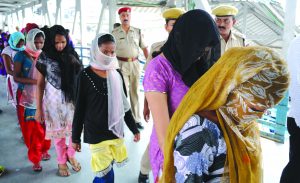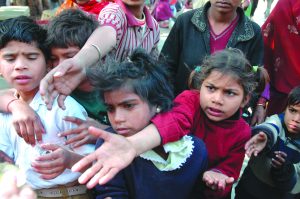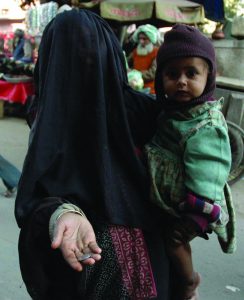 Director, National Crime Report Bureau, Ram Phal Pawar told, “the Supreme Court had vide order dated April 24, 2019 had asked the government to file response on the report of a panel constituted by the Apex Court. The panel had been constituted to assist and advice the Supreme Court on prevention of trafficking, rehabilitation of sex workers who wish to leave sex work and conditions conducive for sex workers to live with dignity”.
Director, National Crime Report Bureau, Ram Phal Pawar told, “the Supreme Court had vide order dated April 24, 2019 had asked the government to file response on the report of a panel constituted by the Apex Court. The panel had been constituted to assist and advice the Supreme Court on prevention of trafficking, rehabilitation of sex workers who wish to leave sex work and conditions conducive for sex workers to live with dignity”.
In its report released on February 3, 2020, the NCRB disclosed that during year 2016, 2017, and 2018 a total of 2,90,439, 3,05,267, and 3,47,542 people have been reported as missing. During the same period, the number of missing women each year is more than the men for the years 2016, 2017 & 2018. As per the NCRB report, a total of 1,74,021 women in year 2016, 1,88,382 in 2017 and 2,23,621 in 2018 have been registered as ‘missing’. Maharashtra, West Bengal, and Madhya Pradesh have reported maximum number of missing women. In fact among the three most vulnerable States of Maharashtra, West Bengal and Madhya Pradesh.
Maharashtra on top
In Maharashtra, the maximum number of missing women is from the Mumbai, Pune and Thane during the years 2017, and 2018. These districts appear to be most vulnerable. Mumbai Commissionerate recorded highest number of missing women during 2017 and 2018 with 4,718 and 5,201 women missing respectively. Both the years, Pune Commissionerate was second with 2,576 in 2017 and 2,504 in 2018.
In West Bengal, Kolkata district has reported maximum number of missing women during 2018 with 2,584 missing women reported. Nadia district has climbed the ladder from being at fourth in 2017 (1,708 missing women) to second in 2018 (2,468 missing women) among the districts of West Bengal. Also in West Bengal, Kolkata District has reported maximum number of missing Children. In Madhya Pradesh, Indore has reported maximum number of missing women.
Under-reporting
Even this number could be more because for the first time in a decade, the unit-level data of the National Family Health Survey (NFHS) allows us to calculate the trends in under-reporting of crimes by comparing data on actual experiences of crime victims with that of crimes recorded by the police, and compiled by the National Crime Records Bureau. This shows that only a minuscule portion of incidents of sexual violence is reported to the police. For instance an estimated 99.1% of sexual violence cases are not reported, and in most such instances, the perpetrator is the husband of the victim. The average Indian woman is 17 times more likely to face sexual violence from her husband than from others, the analysis shows. The NFHS is a nationally representative survey covering nearly 700,000 women. Detailed questions on sexual and physical violence were asked to a sub-sample of 79,729 women and in the absence of a nation-wide crime victimization survey, the NFHS remains the most credible source on crimes against women.
This suggests that the absence of a strong law against marital rape and assaults is not the only factor behind the low reporting. There are other factors at play, including low trust in the police and low conviction rates in such crimes that prevent women from reporting sexual assaults. The picture is pretty similar if one compares the overall level of violence (sexual and physical) faced by women as recorded in the NFHS survey data versus what is recorded by the NCRB.
A state-wise analysis suggests that the extent of under-reporting tends to be higher on average in states with low female literacy. In states such as Bihar, Uttar Pradesh and Jharkhand, less than 0.5% of incidents of violence against women were reported. Tamil Nadu and Karnataka also saw very low reporting of such crimes despite a higher female literacy rate. The estimated reporting rate is relatively higher for states such as Delhi, Assam, Rajasthan, Kerala, Maharashtra and Himachal Pradesh. Barring Rajasthan, all these states have relatively high female literacy rates. The NFHS data provides further corroboration of this. Only 3.5% of victims of violence reported seeking the help of police. It is likely that among them, some failed to register a case even after seeking help.
Missing children
 The number of missing children is maximum in the State of Madhya Pradesh, West Bengal, Delhi and Bihar. The Rohini and Outer District of Delhi have reported maximum number of missing children. In Madhya Pradesh, the maximum number of missing children is from the district of Indore. In Madhya Pradesh, Indore retains the top position in year 2017 and 2018 with 1,755 and 2,458 numbers of missing women respectively. Satna district has surged in 2018 in number of missing women.
The number of missing children is maximum in the State of Madhya Pradesh, West Bengal, Delhi and Bihar. The Rohini and Outer District of Delhi have reported maximum number of missing children. In Madhya Pradesh, the maximum number of missing children is from the district of Indore. In Madhya Pradesh, Indore retains the top position in year 2017 and 2018 with 1,755 and 2,458 numbers of missing women respectively. Satna district has surged in 2018 in number of missing women.
The report has revealed that Odisha recorded a steep rise in the number of cases registered in connection with ‘missing women’ in 2018. The report states that their relatives at various police stations in the state registered 6,378 cases of ‘disappearance of women’ during 2016. In fact, Odisha jumped to the seventh position in the list of states with the highest number of ‘missing women’ cases in 2018. The state stood at 16th position in the list during the previous year.
Alarmingly, Odisha tops the states and Union Territories in terms of the percentage increase in reports filed with police on ‘missing women’ in 2018. Data further revealed the extremely poor performance of Odisha Police in tracing the whereabouts of the missing persons as compared to other states. The state was at the bottom among the states and Union Territories as Odisha Police could trace only 25 per cent of the women who went missing during 2018. Similarly, Odisha Police succeeded in tracing only 29.2 per cent males who reportedly went missing during the same period.
As for as missing children are concerned, during the year 2016 a total of 63,407 children, during 2017, 63,349 children, and during 2018 a total of 67,134 children have been reported as missing. In West Bengal, Kolkata district had maximum number of missing children in 2018 with 989 cases. Nadia district has surged from 291 in 2017 to 474 in 2018. Indore in Madhya Pradesh reported highest number of missing children during 2017 and 2018 with 596 in 2017 and 823 in 2018. Satna has surged from 360 in 2017 to 564 in 2018. In Bihar, Patna district has reported maximum number of missing children. Patna district in Bihar has highest number of missing children in both 2017 (631) and 2018 (759). Muzaffarpur has surged from 228 in 2017 to 412 in 2018.
On an average, a child goes missing every 10 minutes in India, according to the Women and Child Development ministry website for tracking missing children. At this rate, around 60,000 children would have been reported missing in the last one year in India. Only about half of them would have been traced, if one goes by the police record on missing children.
NCRB data
 The National Crime Records Bureau (NCRB) data on missing children for 2018 reports higher number of missing children (63,407) than what is estimated through the WCD ministry’s child tracking website. India is home to more than 400 million children below the age of 18 years, and is considered one of the countries in which youth and children comprise more than 55% of the population.
The National Crime Records Bureau (NCRB) data on missing children for 2018 reports higher number of missing children (63,407) than what is estimated through the WCD ministry’s child tracking website. India is home to more than 400 million children below the age of 18 years, and is considered one of the countries in which youth and children comprise more than 55% of the population.
These missing children represent diverse cultures, religions, castes, and communities, social and economic groups.
It says the cases of missing children represent a conglomeration of problems like kidnappings by family members or by non-family members or strangers and children who run away on their own or are forced to run away due to compelling circumstances in their families and extended surroundings. It also includes children who are trafficked or smuggled or exploited for various purpose. In fact the NCRB too has quoted Wikipedia to define a missing person and says, “Some young people run away from homes due to unbearable conditions of abuse and maltreatment. They become vulnerable to trafficking, violence, drug addiction, prostitution and other risks of exploitation and involvement in crime”. It adds that many persons who are missing end up getting trafficked. This suggests rampant trafficking because minor girls are twice as likely to go missing than the minor boys. The data shows that a majority of missing are minor girls. The number on record of the missing children is the tip of an iceberg considering that many cases of missing children are not reported or not recorded by the police, especially in rural areas, despite the National Human Rights Commission’s clear directions to investigate every case with full seriousness. There are many instances, where telling families that their child may have run away and will come back soon often dismisses missing children complaints.
Poor victims
A study, Sociologies of India’s Missing Children, published in an online journal Research Gate on August 14, 2019 shows that most of the missing children are from poor backgrounds and most of them are trafficked to work as bonded labourers or in brothels. The incidence of girls going missing was found to be higher than boys in the study.
Panel has recommended that the ‘National Crime Records Bureau and its State Counterparts that is SCRB should be directed to analyze the data on missing persons (especially on women and children) so that areas prone to persons being trafficked can be identified. This data and analysis should be made public’. As per data on missing persons in crime in India, a total of 2,90,439 people in year 2016, 3,05,267 people in 2017, and 3,47,524 people in 2018 have been reported as missing.
Director, NCRB, Ram Phal Pawar further clarified that “It is a regular occurrence for any police organization to deal with report of a missing person. Some persons will have gone missing in order to avoid abuse or violence. Others may be missing due to an accident”.
However, a percentage of the total number of people who go missing will have been the victims of serious crime. When the missing person is a women or a child, it is a matter of serious concern. Labour and sexual exploitation are two prominent reasons of trafficking. It suggests that low level of education; low employment prospects and lack of opportunities are also the reasons for women and men to venture out in search of better living conditions.
Search service
Director, NCRB, Ram Phal Pawar informed that a citizen services namely ‘Missing Person Search’ is now be available online to Citizens. The Citizens can search for their missing kins against the national database of recovered unidentified found person from their homes. This will hugely benefit relatives of missing persons and save them from running around pillar to post, as all such details including photos are available in Crime and Criminal Tracking Network System and will now be accessible to citizens through this portal at their convenience.
In this user-friendly search, citizen may enter search criteria in the portal and the system will search it from the available national database across country and will display the result immediately with photograph and other details. The NCRB and Cyber Peace foundation together have designed CCTNS Hackathon and Cyber Challenge 2020 with the aim to enhance skills and knowledge of law enforcement personnel at ground level. This Hackathon has been organized to offer a unique experience to the participants,to advance their skills and knowledge and to promote coordination with industry and academia.
The NCRB and National Centre for Missing and Exploited Children’s (NCMEC), USA have signed a Memorandum of Understanding to receive information on such material originating from India. NCMEC is anon-profit organization established by the United States Congress. It has a centralized reporting system by which internet service providers across the world or intermediaries like facebook, youtube, etc. can report about persons who circulate images of child pornography.
Director, Intelligence Bureau inaugurated the Cyber Tip line monitoring facility in the NCRB. He reiterated that intersection between crime and technology is more
apparent today than ever before. Digital technologies and the Internet have not only spurred cybercrimes but also made them much more sophisticated. It is therefore requisite for law enforcement agencies to be agile skilled in the use of latest technology and adopt innovative methods to track, investigate and combat cybercrimes.
Director informed that approximately 25000 Cyber Tip line Reports have been received so far and shared with States/UTs out of which 15 were of very high priority. As per details shared by States/UTs, 57 FIRs have already been registered, and investigation is in process for remaining Cyber Tip line Reports. Yet still, though the Supreme Court mandates that the police register an FIR of kidnappning when they receive a missing child complaint, there are allegations that there is a hesitation on the part of police to lodge an FIR. Also there are cases when police dismisses the complaints by families about missing children telling the families that their child would return on its own.
Trafficking law
The UNODC Global report of 2018 on trafficking in person indicates that the vast majority of the detected victims of trafficking for sexual exploitation are females, and 35 per cent of the victims trafficked for forced labour are also females, both women and girls. At the same time, more than half of the victims of trafficking for forced labour are men. The Global Report indicates that the overall number of reported trafficking victims has increased. This might mean that more people are being trafficked, but also that national capacities to detect this crime and identify victims are improving in some countries. Increases in trafficking convictions have also been recorded broadly tracking the rise in the number of reported victims.
Nearly every country now has legislation in place criminalizing human trafficking. The international community needs to accelerate progress to build capacities and cooperation, to stop human trafficking in conflict situations and in all our societies where this terrible crime continues to operate in the shadows. The common cause of trafficking is forced marriage, child labour, domestic help and sexual exploitation etc.
There is a need for India to strengthen trafficking law, as suggested by the Justice Verma committee because the present law (Immoral Trafficking Act, 1956) only criminalizes trafficking for purposes of prostitution. The committee recommended that provisions of the Indian Penal Code on slavery should be amended to criminalize trafficking by threat, force or inducement. It also wanted criminalizing employment of a trafficked person.
letters@tehelka.com











